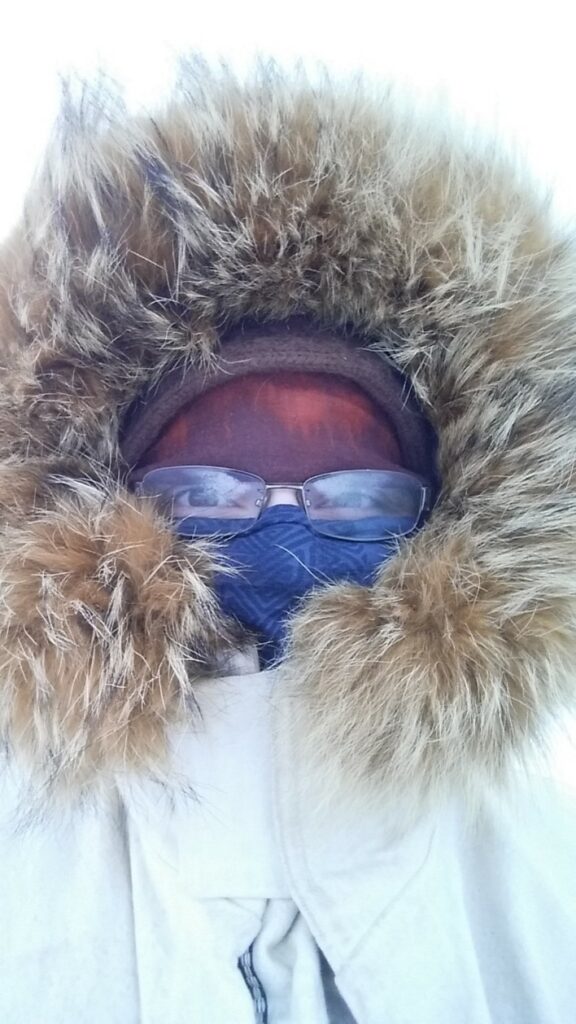Chores in the Deep Freeze

While today feels oddly balmy and I’m running the exhaust fan in my chicken coop to try to keep up with the rising humidity, not that many days ago the farm was gripped in the jaws of the polar vortex.
Of course, we know to expect a cold snap in January. Last year it came early, near Christmas time, but this year it waited and sprang on us rather late—just as February was rounding the calendar’s corner. Every now and then we sneak through a winter without a polar plunge, but not this year.
There’s a reason farmers are obsessed with the weather—radar, predictions, precipitation percentages. Your crop or animal husbandry plans can be thrown asunder by changes in what the weather’s doing. Mother Nature is in charge, and it’s our job to respond accordingly. With hundreds of animals in our care here, that means anticipating needs when the deep freeze strikes.
While urban poultry fanciers were flocking to Walmart to buy camping tents to bring their three to six hens into the house or garage, I was out fluffing up fresh straw in the coop. There simply isn’t room for 150 laying hens in the house—and our detached, unheated garages aren’t any better protection from the chill than the customized coops.
Chicken coops are traditionally made with a shed roof, facing south with a bank of windows. Our main coop also has this orientation, and thankfully deep cold also means no clouds, so the windows catch as much of the solar power as they can during these short winter days. Having fresh, fluffy bedding to snuggle into also keeps bird toes warmer. Piling this on top of the older bedding (known as a deep bedding pack method) allows the lower layers to slowly decompose, making their own heat like a big warm blanket below the dry, fresh layer. I also upped the hens’ ration of stored organ meats, suet, and whole corn to boost protein, fats, and carbohydrates—nutrients they would need to burn in order to make more heat.
Next I wadded up old towels and shoved them into any cracks or crevices in the coop, since blocking the wind is one of the most helpful elements for livestock in such extreme weather. Providing draft-free shelter can change the “feels like” temperature up to 40 degrees. I kept the ducks inside, offering them token amounts of water so they would abstain from bathing and becoming ice-encrusted foul (that wasn’t their idea of a good time, but they obliged). The turkeys, well, they got too stir crazy, so I allowed them outside for a few hours at a time under full sun before bringing out the trusty herding stick and shutting the door.
But when it’s 30 or 40 below outside with a wind chill dipping 10 or so degrees lower, it can be a real danger to the farmer who will be spending one to several hours outside hauling feed and bedding and water. And there’s no “we’ve canceled work today” option on the farm. Even when the mailman had the day off, we certainly didn’t.
Typically, I have to layer on an extra 26 pound of clothing, boots, and gear to face chores in this kind of weather. Forget wearing my glasses, which just fog up instantly. I have my quilted down bomber-style hat, my fuzzy turtle fur neck scarf, thick boot socks, insulated coveralls, and a hooded coat. Sometimes I’ll add a down vest under the coat if I’m not going to be hauling as much and therefore working up a sweat. The drying sweat can be its own danger in deep cold, so over-dressing can become its own hazard.
You know it’s cold when your eyelashes freeze together. I kept having to whip my hand out of my choppers and pull off the ice clumps that would lock top and bottom lashes together. But you know it’s REALLY cold when your nose hairs freeze! It’s moments like that when you’re glad these cold snaps usually only last a few days and not weeks on end.
Most heated waterers for poultry are rated to zero degrees—beyond that forget it, you’re on your own! So each night I would pile all the waterers onto a long sled and pull them into the basement, which has a heated floor. The awkward blocks of ice trapped around and inside the waterers would slowly melt (dripping into the sled), and I would have functioning vessels to refill in the morning. Even still, I had to fill them at the hydrant by the barn right away, or the lids would freeze to the base just in the time it took to walk from the house and the barn!
So while temps are dipping back down from their mid-30’s highs, it looks like we’re out of the woods for now for the January-style deep freeze. Before the last snap had finished, we had Freddie the bottle lamb back in the house (he couldn’t tolerate the cold like his chunkier playmates), an injured duck (the rest of the crew appeared to have ganged up on her), and a hen with frostbite on her comb in the farmhouse, weathering it through. The hen and the duck have since returned, and Freddie has recovered from his bout with pneumonia. Never a dull moment on the farm!
I hope that you have been able to stay warm and safe through the polar vortex. Too mild of a winter is a sloppy mess on the farm, but too harshly cold certainly has its own challenges. Let’s hope for a more even-tempered remainder of the winter. Whichever way it turns, though, know that we’ll be out there doing our very best to keep the animals as comfortable as possible. It’s more bedding hauling for me tomorrow! See you down on the farm sometime.






